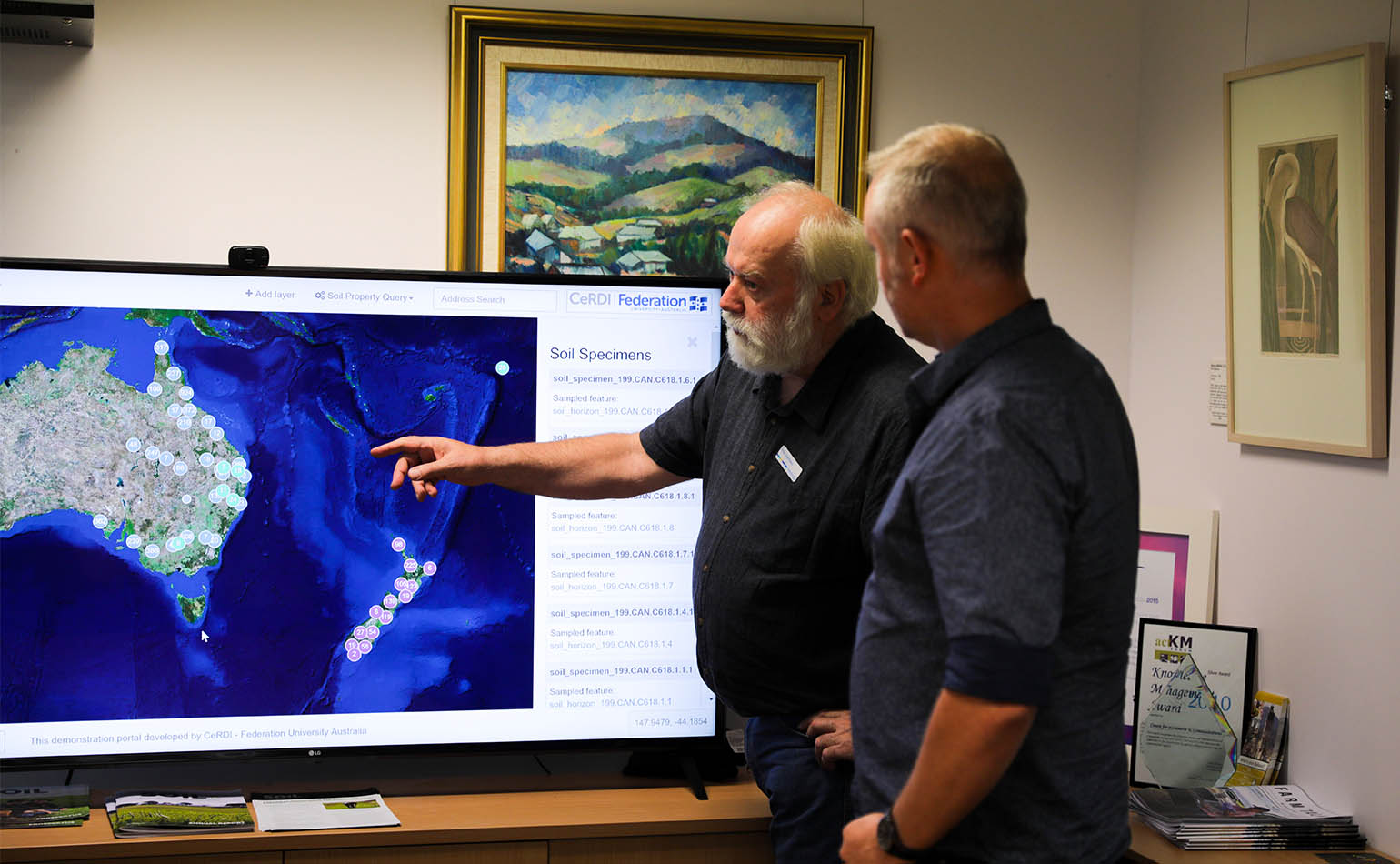Federation University Australia is based in regional Victoria and was formed when the former University of Ballarat and the Gippsland Campus of Monash University were amalgamated in 2014. Federation University Australia has campuses in Ballarat, Berwick, Brisbane, Gippsland and the Wimmera.
The majority of the team from Federation University Australia working with the Soil CRC come from the Centre for eResearch and Digital Innovation (CeRDI) which is led by Centre Director, Associate Professor Helen Thompson.
CeRDI is a global leader in data interoperability and has developed many award-winning web-based spatial information and knowledge portals which provide public access to data sets that are often hidden from view. They have six research themes – Agriculture, Natural Environment, Hazard Planning and Resilience, Health and Wellbeing, Heritage and Culture and Regional Development.
Apart from CeRDI, there are other Federation University Australia researchers involved with the Soil CRC that are making connections across all the campuses, with contributions coming from the Business School and School of Science, Engineering and Information Technology.
Federation University Australia works across all four research programs within the Soil CRC.
Their main focus is on data and knowledge management. The group is working on unlocking the combination of private and public data for research. Much of the data is held by intermediaries, e.g. farmer groups or individual farmers and there is very limited enduring access to data to make the best decisions on soil management. Understanding what custodians need in order to make their data available is vital to many of the Soil CRC projects, but especially to the Visualising Australasia’s Soils project which is led by Associate Professor Peter Dahlhaus from Federation University Australia.
Why the Soil CRC?
The collegiality and the new collaborations with other universities that have occurred from being part of the Soil CRC have been invaluable for Federation University Australia. They have been able to step up their engagement and collaboration with farmer groups as well. With over 20 years’ experience working with some of the local farmer groups, being part of the Soil CRC has really deepened and broadened these relationships. They see that as part of the Soil CRC they are able to share their knowledge and capabilities with a national group. They believe the Soil CRC will accelerate the research and adoption being undertaken.
There are terrific opportunities for knowledge and technology transfer that supports their region in a larger, broader way. They see an opportunity to get their feet on the ground with farmer groups, extending and road testing their research to make sure it is practical, and that it can be adopted and used.
The existing relationships that Federation University Australia have with farmer groups is important to the Soil CRC because the team already understands many of the needs and challenges that these groups face.
The Visualising Australasia’s Soils project is establishing the use case for farmer groups and catchment management and NRM authorities to bring their data to the Soil CRC. They are working on co-creating outputs that are going to be useful for the sector and farmers.
Projects involving Federation University Australia
Visualising Australasia’s Soils – led by Assoc Prof Pete Dahlhaus, Federation University with collaborations from Landcare Research New Zealand, University of Tasmania, University of Southern Queensland, Birchip Cropping Group, Burdekin Productivity Services,
Central West Farming Systems, Gillamii Centre, Herbert Cane Productivity Services, Landmark, Liebe Group, Mackillop Farm Management Group, Mallee Sustainable Farming, North Central Catchment Management Authority, Riverine Plains Inc, Southern Farming Systems, WANTFA, Wimmera Catchment Authority.
‘Smart’ soil sensors – led by Dr Marcus Hardie, University of Tasmania with collaborations from University of Southern Queensland.
Improving decision support systems – led by Dr Keith Pembleton, University of Southern Queensland with collaborations from University of Tasmania, NSW Department of Primary Industries, Burdekin Productivity Services, Birchip Cropping Group, West Midlands Group, Riverine Plains Inc.
New amendments for sandy soils – Dr Richard Bell, Murdoch University, with collaborations from Primary Industries and Regions SA, West Midlands Group, NSW Department of Primary Industries, Australian Organics Recycling Association.
| Researcher | Field of expertise |
| Peter Dahlhaus | Geology, catchment management, soil salinity, spatial data interoperability and visualisation |
| Helen Thompson | Leads the development of world class knowledge management systems and advancement of digital literacy across industries |
| Nathan Robinson | Soil Science, digital soil mapping, agricultural science |
| Megan Wong | Soil biology, FAIR data assessment and standard vocabularies, vegetation and land use change |
| Bruce Simons | Geophysics, information management systems design, data modelling, data exchange mechanisms and interoperability |
| Andrew Macleod | Manages the implementation of major IT projects |
| Heath Gillet | Design, programming, implementation and support of IT systems |
| Joarder Kamruzzaman | IoT, machine learning, data analytics, sensor technologies and cybersecurity |
| Ben Wills | Social science, quantitative and qualitative research, agrifood system innovation |
| Amie Sexton | Social science, social impact research |
| Peter Vamplew | Artificial intelligence, reinforcement learning, neural networks and evolutionary computation |
| Scott Limmer | Decision support systems, IoT, climate and other data |
| Darren Kidd | Land resource analysis |

